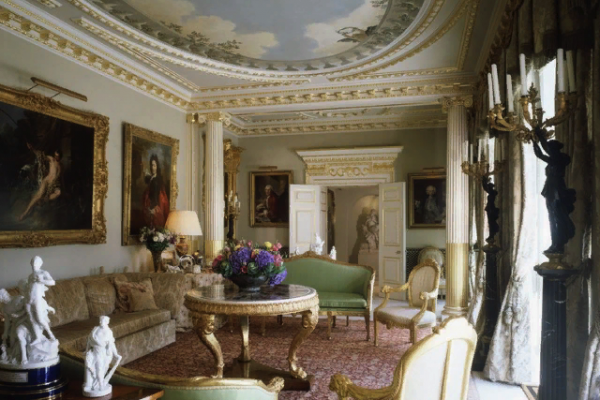His latest project was the restoration of 18th-century orangery at the end of the drive. It is a retreat—no telephones, no television, and no pop music, only classical. There’s a library for writing letters, a gilded salon for champagne before dinner, a chapel to honor people close to him who have died—Versace, Princess Diana, and John’s much-loved grandmother, who had a cozy apartment in the orangery in the last few years of her life.
“She looked after me when I was starting out,” John says. “It was my turn to look after her. I used to say to her, ‘Nan, let me make these rooms nice for you.’ And she would always say, ‘No, dear, you save your money.’ After she died, I wanted to create something in her memory.”
To refurbish the orangery, John again called on Protheroe and Cooper-Grigg, who restored the architecture and gave the spaces symmetry. John shopped for Old Master paintings, Chippendale furniture, and porcelain, which the designers arranged to achieve rooms that are both voluptuous and warm.
Queensdale, John’s London base, is the setting for his collection of blond furniture—particularly Biedermeier pieces—inspired by a visit to the late singer Freddie Mercury’s house. “Freddie had a tallboy of Karelian birch that was so beautiful it could almost have been rare stone,” says John. “Blond wood glows with the colors of the sun.”
The Atlanta apartment was next. John likes the vitality and energy of the city: The music scene is good, and the southern charm means locals are too polite to pester him. An airport is ten minutes away, so he can return by private jet from most places in the United States and be back in his own bed every night.
Stan Topol and Fred Dilger designed the Atlanta apartment to accommodate a large—and growing—collection of photography and contemporary art. Now John has bought the duplex next door, and Dilger and his new partner, Monique Gibson, have created rooms that open up to each other “to show the art as one man’s personal collection, not a museum,” Dilger says. “If Elton likes a photographer, he buys a lot, so I hung acquisitions together, with the same frames. There’s a very good show of Herb Ritts photographs in the guest bath at the moment, but I rearrange things every time he goes away so he can see them with a fresh eye when he returns.”
